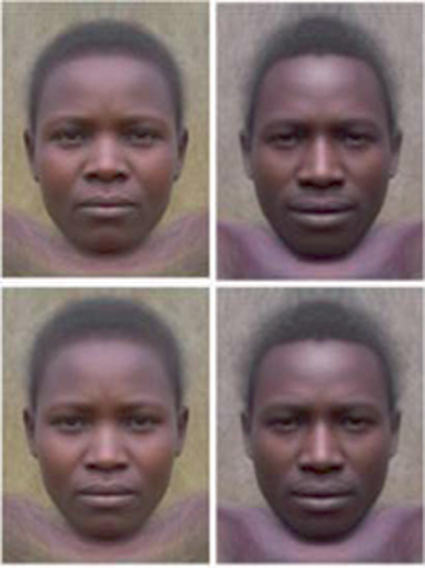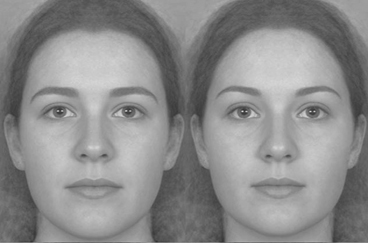Fig. 2.1
Averageness. A composite image made from three images (a), the same image given the color of nine images (b), and a shape and color composite made from nine images (c). Image (c) is typically considered more attractive as it is the most averaged of all the images [13]
In essence, attractive persons are more prototypical of, more representative of, and better examples of a population of faces, even though not common or frequently occurring [23]. Faces near the prototype or average may be processed more fluently, with greater speed and efficiency, and consequently preferred. In two experiments, participants categorized and rated the attractiveness of random-dot patterns or common geometric patterns, with results showing that being prototypical was a predictor of both fluency (categorization speed) and attractiveness [25]. In further support, when comparing neurocognitive and behavioral responses to attractive, unattractive, and averaged human faces, participants categorized averaged and high-attractive faces more rapidly and with a reduced amount and need for neural activity, as tested by event-related potentials [26]. A strong relationship has even been found between averageness and attractiveness for dogs, wristwatches, and birds, supporting a prototype theory [27].
The attractiveness of averageness has been found using both real and computer-manipulated faces with large effect size and cross-cultural agreement (Fig. 2.2) [22]. Evidence shows that young infants prefer to look at average, prototypical faces that adults find attractive [12, 24]. Preferences for averageness have not only been found in westernized societies but have also been found in an isolated hunter-gatherer society, the Hadza of Northern Tanzania (Fig. 2.3) [28]. Given that the Hadza have little exposure to the outside world, they provide very strong support to the argument that the preference for averageness is universal, rooted in biology, and not dependent on media socialization [28]. It has also been found that averaged faces are attractive in both Chinese and Japanese cultures [29].
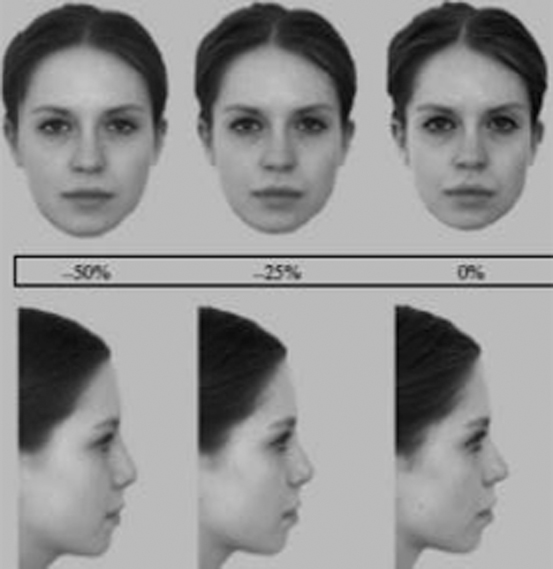

Fig. 2.2
An example of stimuli used in averageness research. In this figure, − 25 % and − 50 % denote 25 % and 50 % morph toward the average from the baseline image of 0 % [42]
It has been suggested that mental representations of what is average are constantly updated by accumulated experience, and it is this experience that determines our internal prototypes and influences what faces we find most attractive [22, 28, 30]. Newborns prefer to look at averaged composites of faces they have seen compared to composites that they have not seen [31]. In a comparison study with 5-year-olds, 9-year-olds, and adults, all groups rated the more average faces of different ages as more attractive, with the association becoming stronger as age increased [32]. It has been suggested that developmental changes may reflect the refinement of an average face prototype as visual perception develops and children are exposed to more faces [32]. Interestingly, viewing contorted faces can adjust one’s perception of a prototype, averageness, and attractiveness. Brief exposure to consistent facial distortions shifts what looks most normal and attractive toward that distortion [33–35]. Young children shown storybooks with distorted (contracted or expanded) faces lead to shifts in judgments of attractiveness, with a higher likelihood of choosing a distorted face as “prettier” after viewing the storybook than prior [36]. This provides evidence that attractiveness judgments are malleable and can be influenced by our surroundings and a continuously updated face prototype. Analogous visual after-effects have been observed following exposure to faces varying in ethnicity, gender, and expression [37]. These findings demonstrate that perceptual adaptation can reconstruct preferences and is thought to reflect changes in the responses of neural mechanisms underlying face processing [13, 38].
Critics have suggested that other factors might explain the appeal of composite, superimposed images [39]. In particular, symmetry is highly associated with averageness and attractiveness. However, averageness independently contributes to attractiveness when symmetry is statistically controlled [29, 40, 41]. In addition, faces photographed in profile, where direct cues to bilateral symmetry are absent, are also judged to be more attractive after being transformed toward the group average [42]. The appeal of averageness cannot be explained by a youthful appearance as it remains attractive when this factor is statistically controlled [43]. It has also been found that forming composite images smoothens skin texture as imperfections and blemishes are averaged. This has been accounted for in multiple studies and even when skin color and texture are controlled for, averageness has been found to independently influence attractiveness judgments [13, 28, 41, 44]. Studies using computerized caricatures and line drawings, which remove the influence of skin tone and texture, have found attractiveness to increase with averageness and negatively correlate with distinctiveness [45]. The importance of averageness to attractiveness judgments is quite robust, and multiple studies have shown that adult preferences for averaged faces cannot be explained by symmetry, blur, youthfulness, or other artifacts that also contribute to beauty which are discussed below [23].
Symmetry
Symmetry refers to the extent to which one half of a figure is the same as the other half around a medial axis. Fluctuating asymmetry (FA) is believed to reflect developmental instability and is described as the random deviation from perfect bilateral symmetry in morphological traits that is produced by genetic or environmental stressors during embryonic development [46, 47]. Fluctuating asymmetries are randomly distributed across individuals so that there is no consistent left or right bias in the population. Directional asymmetries, on the other hand, have a consistent left or right bias across a population (e.g., location of the heart), are not produced by stresses during development, and are not thought to impact attractiveness judgments [48]. Although there are some reports of right-sided facial dominance [48] and enhanced left-sided expressiveness [49], these asymmetries are subtle and do not affect attractiveness. Rather, deviations around them, the fluctuating asymmetries, do affect beauty judgments in that there is a negative correlation between FA and facial attractiveness [50–52].
The preference for facial symmetry spans species and cultures. Macaque monkeys gaze longer at symmetrical than at asymmetrical conspecifics [53]. Researchers have demonstrated that hens repeatedly exposed to asymmetrical stimuli around a symmetrical mean come to prefer symmetrical stimuli to which they have not been previously exposed [54]. Symmetry has long been a fascination in both scientific literature and media. Brad Pitt is considered to have one of the most symmetrical faces in Hollywood (Fig. 2.4). There is even an online tool, Symmeter, that offers a web-based system to measure the symmetry of any person from a digital image [55]. A score is provided on a scale of 100, with the typical human face averaging a 92 [55, 56].
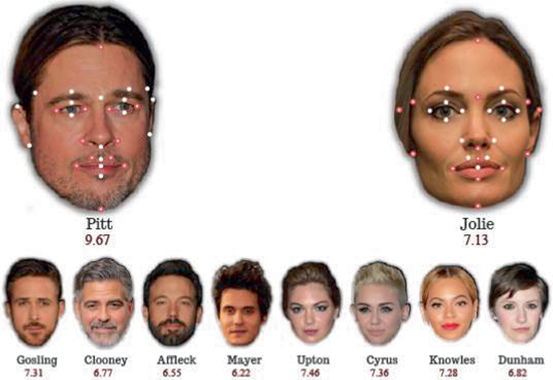

Fig. 2.4
Using a formula based on symmetry and proportions of 29 different points, Dr. Kendra Schmid calculates a score between 1 and 10. Most ordinary people score between 4 and 5 based on this formulation, while celebrities typically score above 6. http://www.huffingtonpost.com/2013/02/26/scientifically-beautiful_n_2741136.html. Graphic by Chris Spurlock. (Source: Kendra K. Schmid, PhD, Assistant Professor, Department of Biostatistics, Director, College of Public Health Masters Programs, Nebraska Medical Center)
Symmetry has been commented on and studied extensively, and the true importance of symmetry has actually been under great debate. In fact, many early studies suggested that symmetrical faces were not preferred to perfectly symmetric versions [23, 57–59]. However, later and more recent studies found that perfectly symmetric faces were more attractive than the original, less symmetric faces [60, 61]. This discrepancy reflects differences in how the perfectly symmetric faces were made [22]. Early studies reflected hemifaces around a vertical midline to create two symmetric chimeras, with slight deviations from frontal views resulting in abnormally wide or narrow chimeras with abnormal eye spacing [22, 57, 58]. Such faces are perfectly symmetrical; however, these images display structural abnormalities in ratios and sizes of the midline features, appearing quite unattractive (Fig. 2.5). The more recent studies made images by using landmarks and blending normal and mirror-reversed images and show that attractiveness can be altered by manipulation of the symmetry level [40, 61]. A meta-analysis confirmed that symmetry is considered attractive when blends are used but not when using chimeras [22].
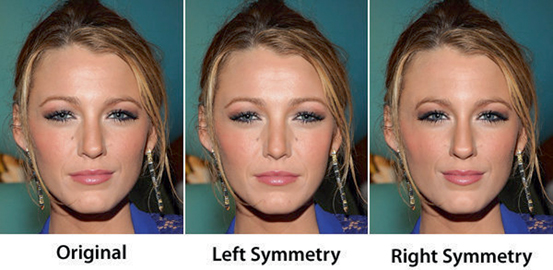

Fig. 2.5
Blake Lively made more symmetrical from left and right chimeras. http://forums.soompi.com/en/discussion/2013148/face-symmetry
Symmetry has been correlated with rated attractiveness from natural, real facial images in both females and males [62–66]. Even in a study of monozygotic twins, the more symmetric twin of the pair was consistently rated as more attractive (Fig. 2.6), and the magnitude of the difference was directly related to the magnitude of the difference in symmetry [67]. Paralleling the findings of naturally occurring symmetry, studies of manipulated faces using sophisticated graphic software with blended images have demonstrated that producing more symmetrical photographs influences attractiveness [60–62]. When averageness and symmetry were independently manipulated, multiple studies have found that these attributes both positively and independently contribute to attractiveness [40, 41]. Faces morphed toward the average were perceived as more attractive, but the effect was significantly stronger with a full-face verse profile view, supporting the independent influence of symmetry [42]. Controlling and accounting for skin texture has also shown an independent influence of symmetry on attractiveness judgments [60, 62]. There is also cross-cultural preference for symmetry. In a study examining the preferences for symmetry in both the UK and Hadza, a hunter-gatherer society of Tanzania, symmetry was more attractive than asymmetry across both cultures and more strongly preferred by the Hadza [68]. In addition, Japanese raters preferred perfectly symmetric versions of facial photographs [29].
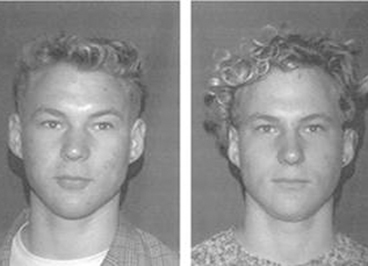

Fig. 2.6
When shown pairs of monozygotic twins, the twin with more symmetric measurements (right) is seen as more attractive [67]
Extrapolated from extensive research, we can conclude that although some degree of symmetry is important to attractiveness, symmetry does not solely determine perceived attractiveness in a range of normal faces with no craniofacial deformities [23]. In fact, perfectly symmetrical faces may not be considered attractive at all. Take Cindy Crawford for example, well known for her asymmetric mole (Fig. 2.7). Imagine moving the mole directly to the center of her face. Although this produces a more symmetrical image, the majority would deem this to be less attractive than the original. Ascertaining the exact contribution of symmetry to attractiveness is difficult, and disparate studies using different methodologies have produced somewhat conflicting results and gender differences; however, the overall consensus leans toward a greater impact of averageness than symmetry [22, 69, 70]. In summary, symmetry is clearly associated with beauty; however, we do not know the extent to which this drives attractiveness judgments.
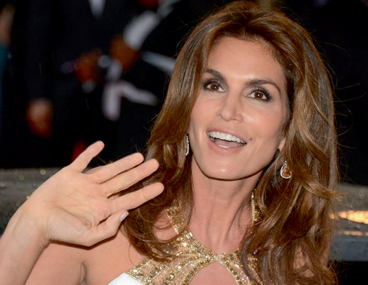

Fig. 2.7
Cindy Crawford. (Photograph courtesy of “Cindy Crawford Cannes 2013” by Georges Biard. Licensed under CC BY-SA 3.0 via Wikimedia Commons—http://commons.wikimedia.org/wiki/File:Cindy_Crawford_Cannes_2013.jpg#mediaviewer/File:Cindy_Crawford_Cannes_2013.jpg
Sexual Dimorphism
Sexual dimorphism refers to the phenotypic difference in adult human faces that reflect the masculinization or feminization of secondary sexual characteristics. During adolescence, sexual dimorphism is ontogenetically enabled by ratios of testosterone to estrogen. In men, a high ratio influences facial growth until the early 20s, facilitating the forward growth of the bones of the eyebrow ridges; the lateral growth of the cheekbones, mandibles, and chin; and lengthening of the lower facial bone [71]. Male typical traits include broader and longer chins, deeper and narrower eyes due to brow ridge development, facial hair, and thinner lips. The influence of estrogen inhibits the growth of these traits and leads to typically female features of smaller jaw, higher eyebrows, fuller lips, and smaller lower to upper face ratio [50]. Hormonal profile and face shape has been linked [13]. Studies show that women with higher circulating estrogen have more feminine faces and men with high testosterone have more masculine features [72, 73].
Evidence that facial sexual dimorphism is attractive is much clearer for female femininity than for male masculinity (Fig. 2.8). Although preferences for masculinity in male faces vary across studies, feminine female faces are consistently found more attractive than masculine female faces [7, 11, 22, 30, 74–77]. This has held true for studies conducted on both naturally occurring and manipulated composite faces [7, 11, 22, 74] and also cross-culturally [73, 74, 78]. In fact, exaggeration of feminine features further increases attractiveness [74, 75, 78]. When subjects were asked to generate beautiful female faces using a computer, they produced faces with more feminine traits than the average [75]. Positively correlated with attractiveness ratings were the feminine neonate features of large eyes, small nose, and small chin; feminine maturity features of prominent cheekbones and narrow cheeks; and expressive features of high eyebrows and large smile [7]. Certain features are considered feminine as they are sensitive to the rise in estrogen levels that accompanies puberty. As women age and approach menopause, androgens increase relative to estrogen levels, causing facial and body features to take a more masculine form. In a study searching for a link between beauty and fertility, faces corresponding to a decreasing level of attractiveness, number of children, and number of pregnancies had thinner lips, flatter noses, broader eyebrows, and more angular jaws than the consensus [50]. More attractive faces had fuller lips, smaller and more tapered noses, higher arched eyebrows, larger pupils, and less angular jaws [50]. The relative contributions of average and nonaverage, sexually dimorphic facial traits to attractiveness judgments in women remain to be investigated.
The link between male masculinity and attractiveness is less clear and, contrary to predictions, studies of women’s preferences for male faces have reported variable preferences [22, 79]. Studies have shown female preferences for masculine faces [65, 79–81], for feminine faces [44, 74, 78], and no effect of masculinity–femininity on male facial beauty [82]. One study showed no evidence of directional selection for increased or decreased testosterone in terms of attractiveness to the male sex [82]. Some groups have found a female preference for feminized male face shapes [74, 78]. These face shapes were also given the positive attributions of cooperativeness, warmth, and honesty opposed to masculinized faces, which were given negative attributions of coldness and dishonesty [74]. A meta-analysis concluded that masculinity is attractive when normal male faces are used but unattractive in manipulated, sex-continua obtained male faces [22]. Although it is still under debate whether women’s masculinity preferences reflect individual differences versus differences in the methods used to construct the stimuli, a study comparing methodology has shown that it is more likely secondary to individual differences as predicted by evolutionary theories discussed in the following chapter [79]. It has been suggested that the preference for feminized male faces may reflect the perception of more positive personality traits (less dominant, more honest, warmer, and more likely to be a good parent) in less masculinized faces [74]. There is evidence that women’s preferences for masculine male face traits change across the menstrual cycle, indicating that women have greater preferences of masculinized male faces during fertile phases [81, 83]. Skin color is sexually dimorphic within all races, with men generally having darker skin than women [83, 84]. Women in the fertile phase have shown preferences for darker complexions in male but not female faces [85]. Preferences for masculine traits in male faces have also been found to interact with the specific context of the judgment (short- or long-term relationship) and life-history variables (presence or absence of a partner) [86]. Women prefer masculine men in short-term partners and more so when there is a presence of a partner in extra-pair copulations [86]. Overall, there is insufficient data to determine whether masculinity is attractive in male faces and is likely dependent on multiple motives and contextual variables.
Body Fat Distribution
Body fat distribution is a sexually dimorphic trait. Sex hormones affect specific regional adiposity and regulate utilization and accumulation of fat [87–89]. The most striking gender-specific difference in the physiology of fat accumulation and utilization are observed in the abdominal and gluteofemoral regions. Testosterone stimulates fat deposits in the abdominal region and inhibits fat deposits in the gluteofemoral region. Estrogen inhibits fat deposits in the abdominal region and maximally stimulates fat deposits in the gluteofemoral region more than in any other region of the body. This produces an android (male) or gynoid (female) body fat distribution. The gynoid and android fat distribution can be ascertained by measuring the waist (narrowest portion between ribs and the iliac crest) and hip (at the level of the greatest protrusion of the buttocks circumference) to compute a waist-to-hip ratio (WHR) [88]. Before puberty, both sexes have similar WHRs; however, after puberty, females deposit more fat on the hips. Therefore, WHR becomes significantly lower in females than in males. WHR has a bimodal distribution, with relatively little overlap between genders [90]. The typical range of WHR in healthy premenopausal women is 0.67–0.80, indicating a more curvaceous body shape with low abdominal adiposity, and is 0.85–0.95 in healthy men [88, 91]. Women typically maintain a lower WHR than men except during menopause when female WHR becomes similar to that of males [88, 92]. Studies show that men judge women with a low WHR as attractive [88, 93–98]. The most preferred WHR in women is 0.7, compared to a mean in most populations of 0.75–0.8 [88]. Studies have also shown a curvilinear relationship between attractiveness and WHR, with 0.7 the most preferred and 0.5 and 1.2 the least [95].
The British model, Twiggy, who embodied slenderness ideals of fashion models in the early 1960s, had a bodily measurement of 31-24-33 (bust-waist-hips), giving her a low female WHR (0.73). In England, one of the earliest cosmetic surgeries consisted of removing two lower ribs to enhance the narrowness of the waist [94, 99]. The popularity of the corset, in spite of the internal injury it caused, and fashionable clothing that stressed tiny waists and exaggerated hips are endorsements for the relationship of waist to hip as a symbol of beauty. In Western societies, a narrow waist set against full hips has been a consistent feature for female attractiveness. Women try to achieve this through body sculpting (e.g., liposuction) and use of various undergarments that work to give the appearance of a slender waist and low WHR. In Hollywood, Kim Kardashian has a WHR of 0.66 and Victoria Secret model, Adriana Lima, has a WHR of 0.68.
Whereas other body features have been given various amounts of importance over the years (such as bust size and overall body weight), the narrow waistline emerges as one of the most enduring bodily features throughout changing ideals of female attractiveness [88]. In the 1980s, Garner et al. studied Miss America contestants [88, 100, 101]. Although contestants were found to become overall significantly thinner, the WHR remained relatively constant, with the average body measurement (bust-waist-hips) of Miss America contestants in 1940 being 34-24.5-35 (WHR = 0.70) and in 1987 being 35-23.5-34.5 (WHR = 0.68). To establish that WHR represents an important feature that men find attractive, further studies have demonstrated that male ratings of female attractiveness are significantly correlated with WHR. The lowest studied WHR of 0.7 in a normal weighted woman was located closer to attractiveness, sexiness, and good health as well as desire and capability for having children than any other figure (Fig. 2.9) [88]. Young children do not show a preference for the waist-to-hip ratio that is found attractive by adults, demonstrating differences in ratings that may reflect pubertal development [102].
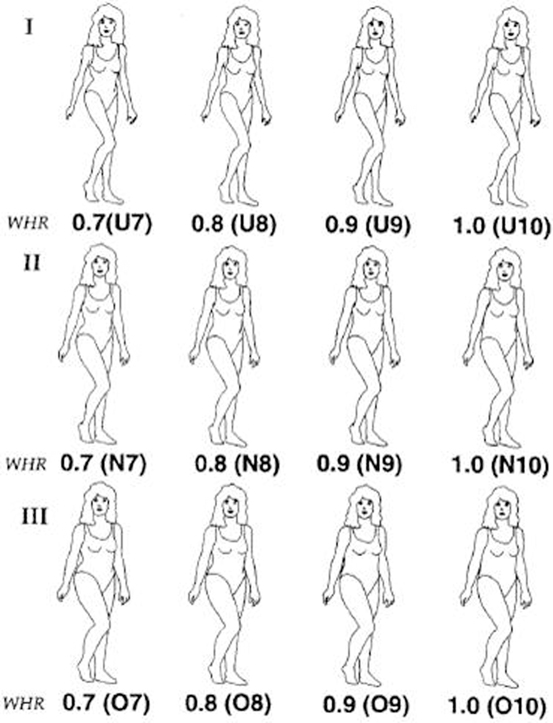

Fig. 2.9
Stimuli of 12 line drawings of female figures, representing 4 levels of WHR (0.7, 0.8, 0.9, and 1.0) and 3 levels of body weight (normal, under-, and overweight) [88]
Since the landmark studies by Singh et al., there has been much debate as to the true effect of WHR on female attractiveness [88, 93, 103–105]. Both anthropometric indices of body mass index (BMI) and WHR explain a high percentage of variance in judgments of attractiveness and tend to positively correlate in both synthesized and natural stimulus sets used in attractiveness research [103]. Multiple studies supporting the role of WHR in attractiveness have manipulated WHR by altering the width of the waist in line drawings or photographic images which also changes BMI [10, 88, 94, 106, 107]. In a recent attempt to address this, observers were asked to rate pre-and postoperative photos of women who had plastic surgery to redistribute fat from around the waist to the hip and buttocks regions, therefore, manipulating WHR but not BMI. Postoperative photographs were judged as more attractive, leading to the conclusion that WHR was the key determinant to female attractiveness [93]. However, other studies, made from Western observers, claim that BMI explains the majority of the variance in attractiveness, with a BMI between 20 kg/m2 and 24 kg/m2 being optimal [103, 105]. It may be the case that WHR acts as a predictor of attractiveness but only that component of it that is directly attributable to overall body fat [103]. Although BMI and WHR are positively correlated and associated with bodily attractiveness measures, to the degree that each contribute and covary with one another is under debate.
In regards to the male physique, minimal research has addressed body fat distribution and female preferences for male body features. The waist-to-shoulder ratio (WSR) is generally considered to be sexually dimorphic, and women have been found to prefer men with a “V-shaped” torso, having broad shoulders relative to the waist or hip size [108–110]. In one study, a WHR of 0.8–0.9 and WSR of 0.6 was rated as most attractive in males [108]. An overall predominant theme in male body attractiveness is the presence of high muscularity and low fatness [70]. However, studies are overall limited and have been studied in few cultures.
Skin Homogeneity
Skin homogeneity refers to the even distribution of skin color and texture. Flawless skin is thought to be a universally desired human trait. This concept is supported by the vast use of cosmetics to refine and create a homogeneous skin surface. Research supports theories that visible skin condition, skin surface topography, and coloration can independently signal attractiveness, youth, and health [111]. In averageness research, it has been shown that the more images that are blended together, the smoother the skin texture becomes, as imperfections such as lines or blemishes are averaged. Skin homogeneity has been considered a confounding factor given the positive effects that averaging skin texture has on beauty [39]. However, averaging in both shape and texture have been found to increase attractiveness independently, showing that increased attractiveness of composites is due to the combined action of both manipulations [44]. Being able to view the world through edges of contrast, even very subtle differences in skin quality can have pronounced effects on facial attractiveness judgments [44, 112]. In an eye tracking study, female facial stimuli with even skin tones attracted more visual attention, and this higher attention was associated with more positive judgments in regards to health and beauty [113]. Many studies have reported a link between texture and color surface cues with both male [44, 85, 114–116] and female [112, 113, 117, 118] facial attractiveness.
Female faces with smooth, homogeneous skin color distribution are typically perceived as younger and receive significantly higher ratings for attractiveness than those rich in contrast [117]. On further manipulation with standardized female stimulus faces and removal of information related to skin surface topography (e.g., facial furrows, folds, wrinkles), visible skin color distribution alone was found to influence attractiveness [118]. Manipulating color and texture information along a continuum influenced female judgments of both the attractiveness and visible skin condition of male faces that was independent of face shape [114]. Utilizing cropped skin cheek images rather than whole face images, skin color homogeneity influenced perceptions of age, attractiveness, and health in male and female faces [112, 116]. Images of skin cropped from younger faces were judged as healthier and more attractive. Perception was strongly related to melanin and hemoglobin distribution, such that more even and synchronous distributions (e.g., homogeneity) led to greater perceived attractiveness [112, 116]. Photoaging is clearly contributory by its production of localized concentrations and subsequent heterogeneous distribution of melanin along with vascular damage and hemoglobin-related chromophore changes [112]. Digitally isolated cheek skin of male faces have shown similar results and the ability to even predict overall attractiveness [115]. Skin health may be a particularly useful marker of current health condition [119] and predict attractiveness as it is more changeable than aspects such as symmetry or averageness. In summary, many studies have shown us the importance of skin homogeneity and independent of facial form and skin surface topography, skin color distribution, evenness, and texture influence the perception of health and beauty.
Stay updated, free articles. Join our Telegram channel

Full access? Get Clinical Tree


